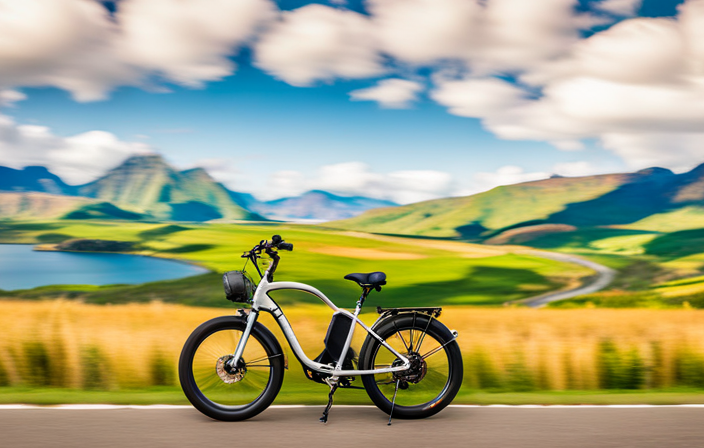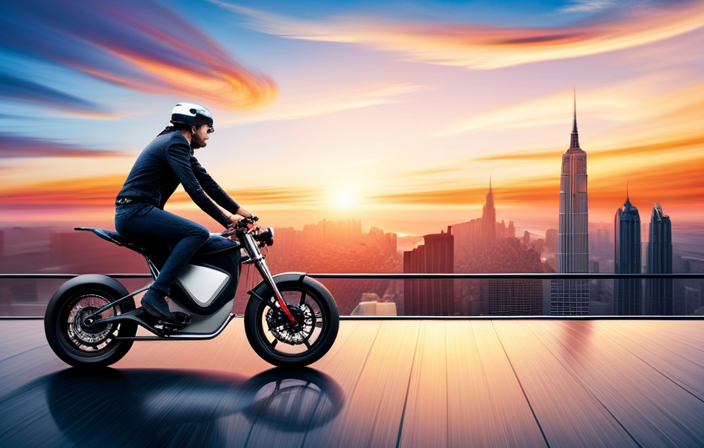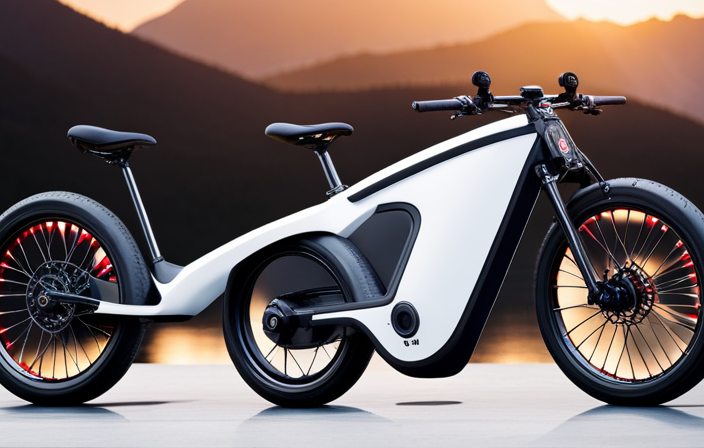“Remember the famous saying, ‘A journey of a thousand miles begins with a single step.’ In the world of electric bikes, knowing the range they can cover on a single charge is essential for mapping out your excursions.”
In this article, we will delve into the factors that affect electric bike range, such as motor types and battery technology. Whether you’re a recreational rider, a delivery person, or someone with mobility challenges, we’ll provide valuable insights to help you choose an electric bike with the perfect range for your needs.
Key Takeaways
- Battery capacity is a key factor determining the available range of an electric bike.
- Terrain, rider weight, and wind resistance all have an impact on the range of an electric bike.
- Range optimization techniques such as adjusting pedal assist levels and riding in eco mode can help increase the range.
- Battery technology advancements have allowed electric bikes to travel up to 100 miles on a single charge.
Understanding Electric Bike Range
You might be surprised by just how far an electric bike can take you. Electric bike range can vary depending on several factors, including range optimization and battery lifespan.
Range optimization refers to the techniques and strategies used to maximize the distance an electric bike can travel on a single charge. This can include things like adjusting the pedal assist levels, riding in eco mode, and avoiding excessive use of the throttle.
Battery lifespan is another crucial factor that affects electric bike range. The lifespan of a battery can be influenced by factors such as temperature, charging habits, and overall battery health. By practicing proper battery maintenance and taking care of your electric bike, you can ensure that it can take you on longer rides without worrying about running out of power.
Now, let’s explore the factors that affect electric bike range.
Factors That Affect Electric Bike Range
One crucial factor impacting an e-bike’s range is the presence of various influencing factors. Understanding range limitations is essential in determining how far an electric bike can go on a single charge.
The primary factor affecting range is the battery capacity, which determines the amount of energy available. Advancements in battery technology have led to higher-capacity batteries that can provide longer ranges.
Additionally, factors like terrain, rider weight, and wind resistance can also affect range. Uphill climbs and off-road trails require more power, reducing the overall distance that can be covered. Similarly, heavier riders may experience shorter ranges due to increased energy consumption. Wind resistance can also impact range, with headwinds causing more drag and reducing efficiency.
Taking all these factors into account is essential for understanding how far an electric bike can go. Transitioning to the subsequent section about ‘types of electric bike motors,’ it is important to consider the motor’s role in determining range limitations.
Types of Electric Bike Motors
When it comes to electric bicycles, the type of motor used can greatly impact the range and performance. There are various types of electric bike motors available, each with its own benefits.
Here is a table that provides a visual representation of the different electric bike motor types and their advantages:
| Motor Type | Benefits |
|---|---|
| Hub Motors | Simple design, low maintenance |
| Mid-drive Motors | Efficient power transfer, better balance |
| Friction Drive Motors | Lightweight, easy installation |
Hub motors are the most common type, located in the center of the wheel, providing a smooth and quiet ride. Mid-drive motors, on the other hand, are positioned near the bike’s pedals, allowing for efficient power transfer and improved balance. Friction drive motors are lightweight and can be easily installed on existing bikes.
Considering the type of motor used is essential in determining the range and performance of an electric bike. Moving forward, let’s delve into the fascinating world of battery technology and range.
Battery Technology and Range
Battery technology has advanced significantly, allowing for greater range and improved performance in electric bicycles. The efficiency of electric bike batteries has greatly increased, thanks to advancements in battery technology. Manufacturers have developed batteries with higher energy densities, meaning they can store more energy in a smaller package. This allows electric bikes to travel longer distances on a single charge.
Additionally, improvements in battery management systems have made it possible to optimize the use of the battery’s power, further increasing the range. With these advancements, electric bikes can now travel up to 100 miles or more on a single charge, depending on factors such as terrain, rider weight, and assistance level.
Moving forward, range testing and real-world scenarios will help determine the actual range of electric bikes in different conditions, providing riders with more accurate information for their journeys.
Range Testing and Real-world Scenarios
Advancements in battery technology have allowed for significant improvements in the range of electric bicycles, enabling them to travel even greater distances on a single charge. Understanding range limitations is crucial for electric bike users.
Range testing is conducted to determine how far an electric bike can go under real-world scenarios. Factors such as terrain, rider weight, and weather conditions can affect the actual range.
To evoke an emotional response in the audience, consider the following sub-lists:
- Freedom: Electric bikes offer the freedom to explore new places without worrying about running out of battery power.
- Confidence: With improved battery technology, riders can feel confident that their electric bike will take them to their destination and back.
- Sustainability: Electric bikes contribute to a greener future by reducing carbon emissions and promoting eco-friendly transportation.
Improving battery technology has revolutionized the range capabilities of electric bikes.
In the subsequent section, we will explore electric bike models with the longest range.
Electric Bike Models with Longest Range
You’ll be amazed at how far these electric bike models can take you on a single charge, like a passport to boundless exploration.
When it comes to electric bike range comparison, some models stand out for their impressive mileage capabilities. The RadRover by Rad Power Bikes, for example, offers a range of up to 45 miles, making it ideal for longer rides and commutes.
Another notable model is the Specialized Turbo Vado SL, which can go up to 80 miles on a single charge, thanks to its lightweight design and efficient motor.
To further improve electric bike range, manufacturers are constantly working on advancements in battery technology and motor efficiency. With these innovations, electric bikes are becoming an increasingly viable alternative to electric scooters and cars, providing a sustainable and eco-friendly transportation option for both short and long distances.
Electric Bike Range vs. Electric Scooters and Cars
Compared to electric scooters and cars, electric bikes offer a more sustainable and eco-friendly transportation option for both short and long distances. When it comes to electric bike range for long distance travel, they prove to be quite impressive.
Here is a comparison of electric bike range with other modes of transportation:
-
Electric bikes can travel up to 100 miles on a single charge, depending on the model and terrain. This range is perfect for commuting, running errands, or even going on weekend adventures.
-
Electric scooters, on the other hand, typically have a range of around 20-30 miles. While they are convenient for short trips, they may not be suitable for longer journeys.
-
Electric cars, with their larger batteries, can travel over 200 miles on a single charge. However, they come with a higher price tag and require more charging infrastructure.
Considering the impressive range of electric bikes, they offer a practical and efficient way to get around.
Moving on to the next section about charging infrastructure and range anxiety…
Charging Infrastructure and Range Anxiety
With the increasing availability of charging stations and the growing concern over range anxiety, it’s clear that the infrastructure for electric vehicles is evolving rapidly.
Charging infrastructure plays a crucial role in addressing range anxiety, which is the fear of running out of battery power before reaching a destination. Having a well-developed charging network gives electric bike riders peace of mind, knowing that they can easily find a charging station when needed.
This infrastructure includes both public charging stations and private charging options, such as home charging stations. Furthermore, advancements in technology have made charging faster and more efficient, reducing the time required to recharge electric bike batteries.
As the charging infrastructure continues to expand, range anxiety will become less of a concern for electric bike riders, allowing them to confidently explore greater distances.
Future of Electric Bike Range
Pedaling potential and power-packed batteries propel the future of e-bike range. As technology continues to advance, electric bike range is improving, making them an even more viable option for transportation. The advancements in electric bike range have a significant impact on the transportation sector, offering a sustainable and efficient alternative to traditional vehicles.
To convey a deeper understanding of these advancements, let’s take a look at a comparison table:
| Electric Bike Model | Range (miles) |
|---|---|
| Model A | 60 |
| Model B | 80 |
| Model C | 100 |
| Model D | 120 |
As you can see, electric bike range has greatly increased, allowing riders to travel longer distances without worrying about running out of battery. This expansion in range opens up new possibilities for commuting, leisure rides, and even longer trips.
These electric bike range advancements are undoubtedly shaping the future of sustainable transportation. With their increased range, electric bikes offer a greener alternative to cars, reducing carbon emissions and easing congestion on the roads. The future is bright for electric bikes and their contribution to sustainable transportation. Now, let’s delve into the exciting world of electric bikes and explore their impact on sustainable transportation.
Electric Bikes and Sustainable Transportation
Electric bikes offer numerous benefits for sustainable transportation.
Not only do they provide a more environmentally friendly alternative to traditional bikes and cars, but they also offer a convenient mode of transport for short to medium distances.
Additionally, electric bikes play a significant role in reducing carbon emissions by eliminating the use of fossil fuels and promoting clean energy.
Moreover, the integration of electric bikes with public transportation systems allows for a seamless and efficient commute, encouraging more people to choose sustainable options for their daily transportation needs.
Benefits of Electric Bikes
Imagine how much easier your daily commute would be on an electric bike, with its ability to effortlessly conquer hills and cover longer distances. Electric bikes offer numerous benefits, including the ability to extend your range and improve your health. With electric bike range limitations being a concern for some, it’s important to note that advancements in battery technology have significantly increased the distance electric bikes can travel on a single charge. Depending on the model and battery capacity, electric bikes can now go up to 60-120 miles per charge. This extended range allows for longer rides and eliminates the worry of running out of power halfway through your journey. Additionally, electric bikes provide a low-impact form of exercise, promoting cardiovascular health and reducing stress on joints. By incorporating electric bikes into our transportation routines, we can play a role in reducing carbon emissions and creating a greener future.
Role in Reducing Carbon Emissions
By incorporating these eco-friendly modes of transportation, we can actively contribute to a cleaner, healthier planet. Electric bikes play a crucial role in reducing carbon emissions and minimizing our environmental impact. Here are three reasons why electric bikes are an excellent choice for eco-conscious individuals:
-
Lower carbon footprint: Electric bikes produce zero tailpipe emissions, making them an environmentally-friendly alternative to traditional vehicles. By opting for an electric bike, you can significantly reduce your carbon footprint and contribute to improving air quality in your community.
-
Energy efficiency: Electric bikes are highly efficient, converting energy from the battery to power the motor. Compared to cars or motorcycles, electric bikes require significantly less energy to travel the same distance, making them a more sustainable transportation option.
-
Reduced resource consumption: Electric bikes require fewer resources to produce and maintain compared to cars. They have fewer parts and do not rely on fossil fuels, resulting in lower environmental impact throughout their lifespan.
By considering the environmental benefits of electric bikes, we can seamlessly transition into discussing their integration with public transportation.
Integration with Public Transportation
As we discussed earlier, one of the key ways electric bikes contribute to reducing carbon emissions is through their integration with public transportation systems. However, it’s important to acknowledge that there are some challenges to this integration.
One of the main challenges is the lack of infrastructure and designated spaces for electric bikes at public transportation stations. This can make it difficult for commuters to easily transition from their electric bikes to buses, trains, or other forms of public transportation.
Despite these challenges, the benefits of integrating electric bikes with public transportation are significant. It allows for a seamless and sustainable multi-modal transportation experience, where individuals can conveniently combine the use of electric bikes and public transportation to reach their destinations. This not only helps reduce traffic congestion and air pollution, but also promotes a healthier and more active lifestyle.
Now, let’s dive into the next section where we will explore the range of electric bikes for commuting.
Electric Bike Range for Commuting
When it comes to commuting on an electric bike, the range requirements are an important consideration. Knowing how far your bike can go on a single charge is crucial for planning your daily commute.
Additionally, it’s essential to consider charging options at work or school to ensure that you can recharge your bike during the day if needed.
Lastly, planning your routes and identifying charging stops along the way can help you optimize your commute and make sure you have enough battery power to get to your destination.
Range Requirements for Commuting
Looking to commute with an electric bike? How far can you go before needing to charge it up?
When it comes to range requirements for commuting, electric bikes have come a long way. With advancements in battery technology, you can now find electric bikes with a range suitable for long distance travel. Some models can go up to 100 miles on a single charge, allowing you to easily tackle those longer commutes.
Additionally, electric bikes are equipped to handle hilly terrain, with some models offering a range of up to 60 miles on challenging routes. So whether you have a long distance commute or live in a hilly area, an electric bike can meet your range needs.
As we explore charging options at work or school, you’ll discover how convenient it can be to keep your electric bike powered up throughout the day.
Charging Options at Work or School
To keep your electric bike powered up throughout the day, you’ll be thrilled to discover the convenient charging options available at work or school. Many workplaces and educational institutions have recognized the growing popularity of electric bikes and have taken steps to accommodate their charging needs. Some offices and schools provide designated charging stations specifically for electric bikes, while others offer access to standard electrical outlets. This ensures that you can easily charge your bike during the day, eliminating any worries about running out of battery power on your commute home. Additionally, some workplaces and schools may even offer the option to charge your bike using solar-powered charging stations, further promoting sustainability. With these workplace and school charging options, you can confidently plan your routes and charging stops without any concerns about running out of power. Now, let’s delve into the next section about planning routes and charging stops.
Planning Routes and Charging Stops
Make sure you plan your routes and charging stops strategically to ensure a smooth and worry-free commute. Planning efficiency is key when it comes to optimizing charging for your electric bike.
Start by researching the charging stations available along your intended route. Look for stations that are conveniently located and offer fast charging options.
It’s also important to consider the distance between charging stops and the range of your electric bike. By taking into account factors such as your bike’s battery capacity, terrain, and weather conditions, you can estimate how far you can travel before needing to recharge.
Additionally, consider incorporating any breaks or lunch stops into your charging plan. By planning ahead, you can maximize your electric bike’s range and minimize any potential charging delays.
With a well-thought-out route and charging strategy, you can confidently embark on your electric bike adventures, knowing that you have planned for optimal charging efficiency.
Electric Bike Range for Recreation and Adventure
With its impressive electric bike range, you can explore the great outdoors and embark on exciting adventures without worrying about running out of battery power. Electric bikes have come a long way in terms of range, making them ideal for off-road trails and mountain biking. These bikes are designed to tackle rough terrain and steep inclines, and their extended battery life ensures that you can go the distance. Depending on the model and battery capacity, electric bikes can typically travel anywhere from 40 to 100 miles on a single charge.
This range allows you to venture deep into nature, enjoy thrilling rides, and discover hidden gems along the way. Now, let’s dive into the next section and explore the electric bike range for delivery and cargo.
Electric Bike Range for Delivery and Cargo
Delivering goods and transporting cargo on an electric bike is like having a mini-truck on two wheels. When it comes to electric bike range for delivery and cargo, it all depends on the specific bike model and battery capacity.
For short-distance food delivery in urban areas, electric bikes can typically cover 20-40 miles on a single charge. This range is suitable for most local delivery services. However, if you’re looking to transport heavier cargo or cover longer distances, you might need an electric cargo bike with a larger battery capacity. These bikes can offer a range of 40-60 miles, making them ideal for courier services and small-scale cargo transportation.
Now, let’s discuss the electric bike range for seniors and disabilities, exploring how these bikes can provide a convenient and accessible mode of transportation.
Electric Bike Range for Seniors and Disabilities
When it comes to electric bike range for delivery and cargo, we discussed the importance of a bike that can go the distance and carry heavy loads. Now, let’s shift our focus to electric bike range for seniors and people with disabilities.
For seniors looking for an electric bike that can take them on long rides, it’s important to consider the range. Many electric bikes on the market today have a range of around 40-60 miles, which is more than enough for most leisurely rides. However, if you live in an area with hilly terrain, you may want to opt for a bike with a higher range to ensure you can conquer those uphill climbs without worrying about running out of battery.
Now that we understand the electric bike range for seniors and people with disabilities, let’s move on to the next section, where we will provide tips for choosing an electric bike with the right range for your needs.
Tips for Choosing an Electric Bike with the Right Range
To choose the perfect electric bike for your needs, make sure to consider the range that will allow you to effortlessly explore the rolling hills and scenic routes.
When it comes to hilly terrain, you’ll want an electric bike with a longer range. Look for a model that offers a higher battery capacity, as this will give you the power needed to conquer those challenging inclines without draining the battery too quickly.
Additionally, if you plan on riding your electric bike during winter conditions, it’s important to choose one with a range that can withstand the colder temperatures. Cold weather can affect the battery performance, so opting for a bike with a slightly longer range will ensure you can still enjoy your rides even in chilly weather.
Remember, finding the right electric bike range for your specific needs will enhance your overall riding experience.
Frequently Asked Questions
Can I modify an electric bike to increase its range?
Yes, you can modify an electric bike to increase its range. There are various ways to achieve this, such as upgrading the battery, optimizing the motor and controller, and reducing resistance. These modifications can significantly extend the distance you can travel on your electric bike.
Are there any legal restrictions on the range of electric bikes?
Legal restrictions on the range of electric bikes vary by jurisdiction, but modifications to increase range are generally allowed. However, it’s important to follow guidelines to ensure safety and compliance with local laws.
How does carrying extra weight affect the range of an electric bike?
Carrying extra weight on an electric bike can decrease its range due to the increased energy required. The battery capacity remains the same, but the additional load puts more strain on the motor and drains the battery faster.
Can I use a regular bike charger to charge an electric bike battery?
No, you can’t use a regular bike charger to charge an electric bike battery. However, you can use a power bank specifically designed for electric bikes.
Are there any safety concerns related to the range of electric bikes?
There are a few safety concerns related to electric bike battery life and factors affecting electric bike range. It’s important to consider the battery capacity, terrain, rider weight, and speed to ensure a safe and reliable ride.
Conclusion
In conclusion, the range of an electric bike depends on various factors such as motor type, battery technology, and usage scenarios. It is important to consider these factors when choosing an electric bike to ensure it meets your specific needs.
As the saying goes, ‘knowledge is power,’ and understanding the range capabilities of an electric bike empowers you to make an informed decision.
So, take your time, do your research, and find the electric bike with the right range that will enhance your riding experience.









